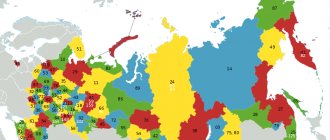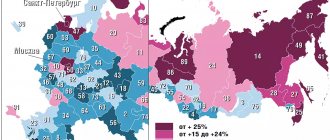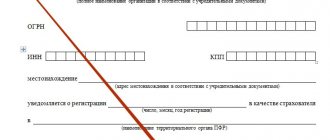Arbitration management. Bankruptcy.
| List of regions | Region code |
| Republic of Adygea | 1 |
| Republic of Bashkortostan | 02, 102 |
| The Republic of Buryatia | 3 |
| Altai Republic | 4 |
| The Republic of Dagestan | 5 |
| The Republic of Ingushetia | 6 |
| Kabardino-Balkarian Republic | 7 |
| Republic of Kalmykia | 8 |
| Republic of Karachay-Cherkessia | 9 |
| Republic of Karelia | 10 |
| Komi Republic | 11 |
| Mari El Republic | 12 |
| The Republic of Mordovia | 13, 113 |
| The Republic of Sakha (Yakutia) | 14 |
| Republic of North Ossetia-Alania | 15 |
| Republic of Tatarstan | 16, 116 |
| Tyva Republic | 17 |
| Udmurt republic | 18 |
| The Republic of Khakassia | 19 |
| Chuvash Republic | 21, 121 |
| Altai region | 22 |
| Krasnodar region | 23, 93, 123 |
| Krasnoyarsk region | 24, 84, 88, 124 |
| Primorsky Krai | 25, 125 |
| Stavropol region | 26, 126 |
| Khabarovsk region | 27, 127 |
| Amur region | 28 |
| Arhangelsk region | 29 |
| Astrakhan region | 30 |
| Belgorod region | 31 |
| Bryansk region | 32 |
| Vladimir region | 33 |
| Volgograd region | 34, 134 |
| Vologda Region | 35 |
| Voronezh region | 36, 136 |
| Ivanovo region | 37 |
| Irkutsk region | 38, 85, 138 |
| Kaliningrad region | 39, 91 |
| Kaluga region | 40 |
| Kamchatka Krai | 41, 82 |
| Kemerovo region | 42, 142 |
| Kirov region | 43 |
| Kostroma region | 44 |
| Kurgan region | 45 |
| Kursk region | 46 |
| Leningrad region | 47 |
| Lipetsk region | 48 |
| Magadan Region | 49 |
| Moscow region | 50, 90, 150, 190, 750 |
| Murmansk region | 51 |
| Nizhny Novgorod Region | 52, 152 |
| Novgorod region | 53 |
| Novosibirsk region | 54, 154 |
| Omsk region | 55 |
| Orenburg region | 56 |
| Oryol Region | 57 |
| Penza region | 58 |
| Perm region | 59, 81, 159 |
| Pskov region | 60 |
| Rostov region | 61, 161 |
| Ryazan Oblast | 62 |
| Samara Region | 63, 163 |
| Saratov region | 64, 164 |
| Sakhalin region | 65 |
| Sverdlovsk region | 66, 96, 196 |
| Smolensk region | 67 |
| Tambov Region | 68 |
| Tver region | 69, 169 |
| Tomsk region | 70 |
| Tula region | 71 |
| Tyumen region | 72 |
| Ulyanovsk region | 73, 173 |
| Chelyabinsk region | 74, 174 |
| Transbaikal region | 75, 80 |
| Yaroslavl region | 76 |
| Moscow | 77, 97, 99, 177, 199, 197, 777 |
| Saint Petersburg | 78, 98, 178 |
| Jewish Autonomous Region | 79 |
| Republic of Crimea | 82, 777 |
| Nenets Autonomous Okrug | 83 |
| Khanty-Mansiysk Autonomous Okrug Yugra | 86, 186 |
| Chukotka Autonomous Okrug | 87 |
| Yamalo-Nenets Autonomous Okrug | 89 |
| 92 | |
| Baikonur | 94 |
| Chechen Republic | 95 |
arbitrat.ru
How to determine the region by TIN?
- By TIN (or rather by its number) you can actually determine in which region it was issued. The TIN of individuals contains 12 digits, legal ones - ten.
In any case, the region is recognized by the first four digits - the first two are responsible for the region, the next two are the number of the department where the TIN was received. See the code decoding table on this website.
- By the TIN number (code), you can determine not only the region in which the document was issued, but also the name of the authority that issued it.
The code can be divided into segments consisting of a certain number of digits. Regardless of whether the TIN is a legal entity or an individual, the first four digits indicate the code of the department that issued the TIN. This code can be entered into the form on the website nalog.ru and you will be given all the information about the region.
- Using the individual taxpayer number (or, in short, TIN), you can determine the region in which a person or organization is registered.
The TIN code consists of ten digits for organizations and twelve digits for individuals and legal entities. The first four digits indicate the Federal Tax Service department code.
In turn, this Federal Tax Service code consists of a region code and a Federal Tax Service division code within this region. And the region code (like car license plates) coincides with the serial N of the region in the Constitution of the Russian Federation.
Maybe it will be useful to someone - there is now a service for deciphering codes (inn, ogrn, checkpoint), you can find it here.
- Indeed, by using the TIN (taxpayer identification number), you can determine the region where the TIN was issued.
If the case concerns any organization, then the TIN consists of 10 digits, but if it is an individual, then of 12. In both cases, the first four digits in the TIN indicate the region (this is the code of the Federal Tax Service region where the TIN was issued).
All that remains is to see which region the code of one or another division of the Federal Tax Service corresponds to.
- You can only find out in which region the TIN was issued. This can be determined by the first two digits - the code of the subject of the Russian Federation. But if a person moves to another region, the TIN is not changed. That is, a person can live, for example, in Moscow, but have a TIN starting with 55 - the code of the Omsk region, because he lived there before and that’s where he was given the TIN. Region codes can be found here.
- Indeed, by using the TIN you can easily find out in which region it was issued, which means where the person lives or is registered with the tax office. You just need to know what they mean.
There are two types of TIN and they have different numbers of digits. For individuals - 12 numbers, and legal entities are assigned 10 numbers.
In a 10-digit TIN, you can find out the region where the TIN was issued by the first four digits. And an ordinary person (12 digits) also uses the first 4 digits. Here two numbers are responsible for the region, and the remaining numbers are the number of the specific branch where the TIN was obtained. For example, in Crimea the first numbers are 82 and 92 (Sevastopol). TIN code table is here.
- According to Federal Law-154 dated December 23, 2003 and the order of the Ministry of the Federal Tax Service dated March 3, 2004 under BG-3-09/178, a unified standard for registration and numbering of certificates for registration of individual entrepreneurs and legal entities "LLC" was established.
First, registration and issuance of TIN to Russian citizens occurs once at the place of their permanent registration (registration).
The TIN number is a set of 10 digits (for legal entities and LLCs) and 12 digits (for entrepreneurs and individuals).
Second, on the merits of the issue, the first two digits in the TIN number mean the number of the region that issued and assigned the TIN to the citizen. Many people sometimes confuse the first digits of the TIN number when an entrepreneur conducts his business in another region of the Russian Federation, considering this region to be the region of registration of the TIN.
The second two digits in the TIN number just mean the number of the tax office that issued the certificate (TIN).
- Using your TIN number, determining the region is quite possible and completely easy. This can be done for both legal entities and individuals. So, it is precisely the first four digits in your TIN code that will imply the region you are looking for; all that remains is to decipher the specific region by numbers in the directory here and that’s it.
- The first two digits in your TIN are the number of your region, and the next two digits are the number of your tax office, where you submit reports and declarations.
- The TIN of individuals and legal entities contains in the first four digits the code of the department of the Federal Migration Service of Russia that issued the identification code. You need to find a directory of four-digit codes for FMS departments to find the region by TIN.
- You can determine the region by TIN as follows; the first two digits indicate the region where the Entrepreneur or legal entity is registered; regardless of its status, either LLC, or CJSC, or OJSC.
The second two digits mean; number of the tax authority where you registered as a taxpayer.
Entrepreneurs, if they are engaged in business activities in another region, then the TIN remains the same, but they are temporarily registered with the tax authority of another region and pay taxes there, but insurance contributions to the Pension Fund are paid at the place of issue of the Certificate of Registration and assignment of the TIN
- In the TIN of both an individual and a legal entity, each number has its own functional purpose and carries certain information.
Thus, the region can be compared with the table below and the first two digits of the TIN.
info-4all.ru
Taxpayer identification number
TIN of an individual
TIN - taxpayer identification number. It is assigned once, is used throughout the Russian Federation and does not change, even if the taxpayer changes his place of residence, surname and other passport data. If desired, you can obtain a Certificate of Registration of an individual from any tax office.
TIN of an individual entrepreneur
Assigned upon registration of an individual as an individual entrepreneur, if this person did not previously have one. Otherwise, the existing TIN is used.
TIN of a legal entity
TIN of a legal entity is a sequence of 10 Arabic digits, of which the first two represent the code of the subject of the Russian Federation in accordance with Article 65 of the Constitution (or “99” for the interregional inspectorate of the Federal Tax Service of Russia), the next two are the number of the local tax inspectorate, the next five are the tax record number taxpayer in the territorial section of the Unified State Register and the last one is the control digit.
The TIN together with the checkpoint make it possible to identify each separate division of a legal entity, therefore both of these codes are often displayed and used together, for example, when indicating the payment details of organizations.
TIN of a foreign legal entity
Since January 1, 2005, it always starts with the numbers “9909”, the next 5 digits correspond to the Foreign Organization Code, the last one is the check digit.
Interregional Inspectorate for Major Taxpayers No. 9
Contacts
Physical adress:
127051, Moscow, Rakhmanovsky lane, 4, building 1
Legal address:
127051, Moscow, Rakhmanovsky lane, 4, building 1
Telephone:
reception of the head of the inspection + 7 department of work with taxpayers + 7 + 7 (495) 913-11-75 Contact center 8-800-222-2222 help service + 7 (495) 913-11-58 “Helpline” +7
Fax machine:
absent
Boss:
Te Evgeniy Antonovich
Working hours:
↑To the top of the page
| Inspection opening hours: break 13.00-13.45 | |
| Mon. | 9.00-18.00 |
| Tue | 9.00-18.00 |
| Wed. | 9.00-18.00 |
| Thurs. | 9.00-18.00 |
| Fri. | 9.00-16.45 |
Additional Information:
Schedule of personal reception of citizens
| Position Full name | Days and hours of personal reception |
| Head of Inspectorate Tyo Evgeniy Antonovich | Wednesday from 15.00-17.00 |
| Deputy Head of Inspectorate Mukhachev Alexander Vladimirovich | Monday from 16.-18.00 |
| Deputy Head of Inspectorate Gulyaev Maxim Sergeevich | Tuesday from 11.00-13.00 |
| Deputy Head of Inspectorate Sycheva Tatyana Nikolaevna | Wednesday 11.00 – 13.00 |
| Deputy Head of Inspectorate Boldyreva Marina Viktorovna | Friday from 14.00-16.00 |
| Deputy Head of Inspectorate Gribova Olga Pavlovna | Thursday 11.00-13.00 |
| And about. Deputy Head of the Inspectorate Kaminsky Andrey Leonidovich | Thursday from 11.00-13.00 |
Information on placing orders for the supply of goods, performance of work and provision of services for the needs of the inspection is published in a unified information system on the official website www.zakupki.gov.ru
Activities:
The Inspectorate carries out tax administration of the largest taxpayers in the financial, credit and insurance sectors
www.nalog.ru
Decoding TIN, checkpoint and other codes #legislation #EDS #ECMJ
Ivan Begtin's blog
The meaning of numbers in passport numbers, TIN and other official documents. The following blogs will reveal the magic of numbers of bank identification codes, current and correspondent accounts, bank cards, as well as codes of the All-Russian Classifier of Economic Activities and some others...
TIN
Taxpayer identification number (TIN) is a digital code that streamlines the accounting of taxpayers in the Russian Federation. Assigned to both legal entities and individuals. It has been assigned to organizations since 1993, to individual entrepreneurs - since 1997, to other individuals - since 1999 (from the beginning of the first part of the Tax Code of the Russian Federation) (see TIN on Wikipedia).
By the way, information about the TIN also contains a qualified electronic signature certificate of a legal entity.
There are two types of TIN in Russia: TIN of an organization - 10-digit and TIN of an individual or individual entrepreneur - 12-digit.
The general structure of the TIN is similar.
So the 10-digit TIN of organizations consists of the following parts:
● 4 digits - department code of the Federal Tax Service of Russia (SOUN directory);
● 5 digits - unique taxpayer number within this division of the Federal Tax Service;
● 1 digit – verification code according to the verification code.
The TIN of an individual consists of 12 digits, differs slightly and consists of:
● 4 digits - department code of the Federal Tax Service of Russia (SOUN directory);
● 6 digits - taxpayer number, unique within this division of the Federal Tax Service;
● 2 digits - verification code according to the verification code.
You can read more about how to check TIN codes at https://www.polytech.ural.ru/checkvalues.htm
I will dwell in more detail on what information the TIN carries.
1. Using the TIN, you can always and unambiguously determine the region of an organization/individual, since the Federal Tax Service division code consists of the region code + the code of the Federal Tax Service division within a given region. The region code corresponds to the serial number of the region in the Constitution of the Russian Federation - by analogy with car license plates and so on.
2. Using the code of the Federal Tax Service division, it is possible, with some error, to determine the location of the division and the area it covers, respectively, the location of the person/legal entity. For legal entities, this is of little relevance, since information on their location is already available online with great detail, according to physical information. There is no such information online for individuals, and there shouldn’t be.
3. Taxpayer number is an incremental number. If you take a closer look and look at at least a few TINs, you will notice that the later an organization is registered, the larger this number is. Accordingly, knowing the dates of registration of several organizations at intervals of values, one can with some probability assume the time of issuance of the TIN for another organization. However, retrieving this information for TIN of organizations is not relevant, since information about the date of issue of OGRN/TIN is already provided by the Federal Tax Service online.
4. It is possible to check the TIN, both by the control code and by the Unified State Register of Legal Entities, provided by the Federal Tax Service in the public part at https://egrul.nalog.ru/fns/
checkpoint
The registration reason code (RPC) is a nine-digit digital code, which, together with the organization’s TIN, allows you to uniquely identify its separate divisions (see KPP on Wikipedia).
Checkpoint structure:
4 digits - department code of the Federal Tax Service of Russia (SOUN directory);
2 digits - reason code for registration;
3 digits - serial number of registration.
In most cases, the checkpoint looks like this: Federal Tax Service division code + 01001 since not many organizations have separate divisions.
The disadvantages of the checkpoint include the impossibility of checking the checkpoint using a checksum. At most, you can check the “reasonableness” of filling out each of its elements. In general, the checkpoint does not carry more information than the TIN, and is almost never used separately in the organization’s TIN.
OGRN
Main state registration number (OGRN) - the state registration number of the record on the creation of a legal entity or the record on the first submission in accordance with the Federal Law “On State Registration of Legal Entities” of information about a legal entity registered before the entry into force of this Law (clause 8 of the Rules of Administration Unified State Register of Legal Entities) (see OGRN on Wikipedia).
OGRN structure:
● 1 digit – code, OGRN sign (always equal to 1);
● 2 digits - the last two digits of the year the entry was made in the state register;
● 2 digits - region code according to the list of regions in Article 65 of the Constitution
● 7 digits — serial number of the record from the beginning of the year;
● 1 digit – OGRN verification code.
What you can find out by knowing the OGRN:
1. Year of registration of the organization according to the last two digits.
2. With some accuracy, the month (or maybe even a week) of registration of the organization according to the serial number of the record.
3. Region code of the organization according to Article 65 of the Constitution.
4. Using the OGRN code, other public information about the organization can be obtained - TIN, KPP, name, address from the public register of the Federal Tax Service.
Please note that INN and OGRN differ in the principles of maintaining serial numbers of organizations. If in the TIN they are linked to the tax office, then in the OGRN they are linked to the year of registration. Accordingly, based on the ability to determine the date of its assignment by the serial number of the TIN, we can say that the TIN carries a little more information (inspection number) than the OGRN.
Passport ID
The passport number consists of 10 digits, where the first 4 are the series number, and the last digits are the number in this series.
But there are also certain features. Of the 4 digits in the series, the first two are digits of the region, but not according to Article 65 of the Constitution, but according to OKATO.
The big open question is what the next two numbers actually are. They are definitely not the last digits of the year the document was issued, even according to passport data disclosed in the public domain, for example, in court decisions you can see that passports with the numbers 07 could be issued in 2003 and 2004.
My guess is that the last two digits of the series are, in fact, part of the number, since the dependence of the number of the last two digits of the series + number on the date of issue of the document is noticeable.
Yes, to the question of why the name of the Department of Internal Affairs and the date of its receipt are always written along with the passport number. If the INN code provided for the SOUN directory, then the passports, in fact, inherited their numbers from the Soviet ones and nowhere, at least in the public domain, is there still no register of responsible police departments, and the number itself will not allow identifying the police department by its code.
And, of course, the key is not extracting information from a specific number or identifier, but obtaining by linking sets of external directories.






